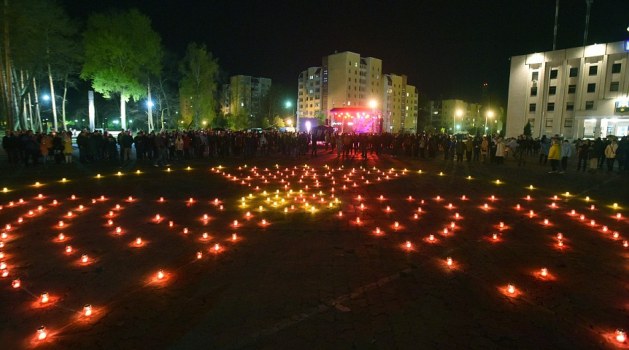
Candles set in the shape of a radiation hazard symbol are seen on a square next to the monument to Chernobyl victims in Slavutych on the 30th anniversary of the nuclear power plant disaster which has killed thousands and permanently poisoned swathes of eastern Europe – AFP/Getty
CHERNOBYL, Ukraine, Apr 26 – Ukrainians held candlelit vigils Tuesday to mark 30 years since the world’s worst nuclear accident at Chernobyl spewed radiation across Europe and left several thousand people dead or dying.
Church bells rang and mourners laid flowers at Chernobyl’s memorial square as the clock turned 1:23 am — the moment when the plant’s reactor number four exploded and changed the fate of a generation living across the former Soviet Union.
“There was crying and screaming,” local pensioner Maria Urupa told AFP as she recalled the terror that struck locals as they watched poisonous clouds of radiation waft in from Chernobyl.
At least 30 people were killed on site and several thousand more are feared to have died from radiation fallout in what Ukrainian President Petro Poroshenko said “appears to have been the world’s largest man-made catastrophe”.
The exact number of dead remains a subject of intense debate because the Soviet authorities kept most of the information about the disaster under wraps.
More than 200 tonnes of uranium remain inside the crippled reactor that spattered radiation across three quarters of Europe after a botched safety test.
Lingering fears of new leaks occurring should the ageing concrete structure covering the toxins collapse have prompted a global push to fund the construction of a giant new arch that could keep the site safe for at least a century.
“We are deeply grateful to the whole international community,” Poroshenko said after laying flowers before the memorial plaques honouring those who died trying to contain the damage.
“In a certain sense, Chernobyl accelerated the (1991) collapse of the Soviet Union, helping opposition and anti-imperialist movements to emerge in Ukraine and bringing our independence a step closer,” the pro-Western leader said.
“At the same time, it created powerful fears of nuclear energy and anti-nuclear sentiments,” he added.
‘They told us nothing’
The plant’s reactor exploded on April 26 and burned for 10 days in a disaster that horrified the world but which locals only heard about through rumours and tidbits from jammed Western radio broadcasts.
The Communist Party kept to its steadfast tradition of saying nothing or even lying in order to keep the public from learning of a tragedy that could tarnish the image of the Cold War-era superpower.
And it took them a day-and-a-half to evacuate the 48,000 inhabitants from the nearby town of Pripyat.
International suspicions were only raised on April 28 after Sweden detected an unexplained rise in its own radiation levels.
Communist Party Secretary General Mikhail Gorbachev winner of the 1990 Nobel Peace Prize for championing democratic and economic reforms did not publicly admit the disaster until May 14.
“Nobody told us anything. There was only silence,” local resident Yevgeny Markevich recalled in an interview with AFP.
But the authorities did relocate 116,000 people that year from the 30-kilometre (19-mile) exclusion zone that still surrounds the now-dormant plant.
Some 600,000 people who became known as “liquidators” mostly emergency workers and state employees were dispatched with little or no protective gear to help put out the toxic flames and clean up surrounding lands.
Invisible poison
The UN Scientific Committee on the Effects of Atomic Radiation officially recognised that around 30 of the workers died in the inferno.
A controversial UN report published in 2005 estimated that “up to 4,000” could eventually perish from the invisible poison in Ukraine and neighbouring Russia and Belarus.
The Greenpeace environmental group the next year issued its own study estimating that 100,000 had already lost their lives.
The 1979 Three Mile Island incident in the US state of Pennsylvania and Chernobyl’s explosion prompted a strong shift in public opinion against nuclear power and only a handful of US plants were commissioned between 1986 and 2013.
The Chernobyl tragedy also fanned the rise of Green parties in Germany and other European nations that relied heavily on nuclear fuel.
Monster cage
Fears that a structure hastily built over the stricken Chernobyl reactor was cracking saw more than 40 countries pitch in 2.1 billion euros ($2.4 billion) for the creation of a new 25,000-tonne protective steel barrier in 2010.
About 165 million euros more are expected from the G7 group of world powers and the European Commission.
The giant arch is wide and tall enough to cover the Notre-Dame Cathedral in Paris and weighs three times more than the Eiffel Tower.
Most of the main work has now been completed and the structure is being fitted out with high-tech equipment that — if everything goes according to plan will be able to decontaminate the hazardous material inside.









































